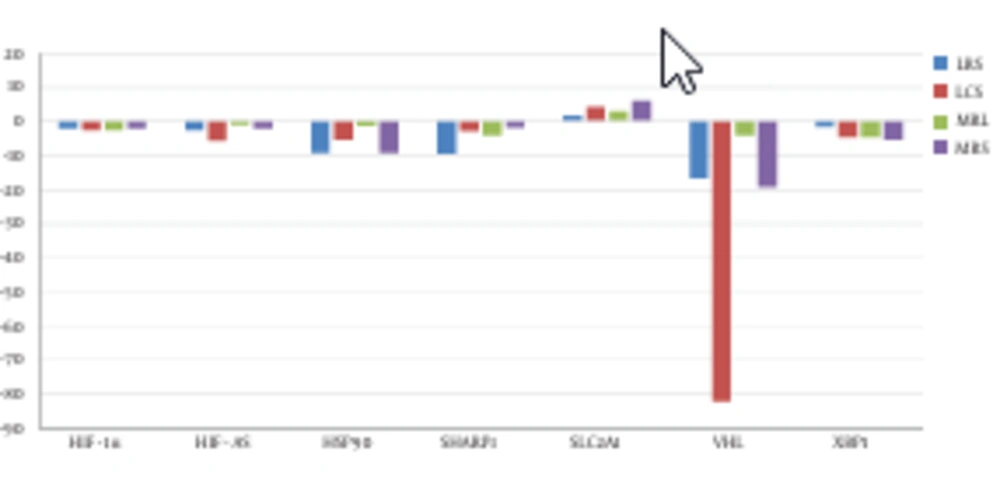Dear Editor,
Hypoxia-inducible factor 1 (HIF-1) has been shown to stimulate the expression of genes that are implicated in critical aspects of tumorigenesis, including angiogenesis, cell survival, glucose metabolism and invasion (1). In order to break the vicious cycle triggered by HIF-1α in cancer cells, several HIF-1α inhibitors have been developed. However, regulation of the HIF-1α is quite complex which made the process of design of HIF-1α inhibitors very problematic (2). In a recent study accepted for publication in “Cell journal” we have demonstrated the modulatory effects of two probiotics namely Lactobacillus crispatus (L. crispatus) and Lactobacillus (L. rhamnosus) on expression of selected genes from HIF-1 pathway in MDA-MB-231 breast cancer cells. In the mentioned study, we have shown that culture supernatant of L. rhamnosus can significantly downregulate HIF-1α expression in addition to expression of other oncogenes in HIF pathway and suggested this probiotic as a natural HIF-1 inhibitor (3). Considering the protective role of lactobacilli against cervical cancer (4), we hypothesized that lactobacilli can influence the expression of the same genes in cervical cancer HeLa cells. Further supports for this idea have been provided by a previous study in which we had shown the cytotoxic effect of the mentioned lactobacilli on HeLa cells and their inhibitory effects on the expression of human papilloma virus (HPV) 18 E6 oncogene as well as autophagy genes (5). Furthermore, lactobacilli have been shown to modulate expression of several immune related genes as well as genes participating in carcinogens metabolism and DNA oxide damage pathways (6). As cancers are believed to be caused by deregulation of several genes, cytotoxic effects of anticancer agents can also be attributed to the modulation of various genes and pathways. In addition to the role of HPV in cervical cancer development, hypoxia has been identified as a major characteristic of clinically advanced cervical cancers (7). Considering the role of hypoxia as a therapeutic and prognostic factor linked to radio resistance, prevention of apoptosis, changes in proliferation, cell signaling, and genomic stability in cancer (7), HIF-1 regulatory pathway modulation may have therapeutic values in this type of cancer. In addition, HIF-1α expression is shown to be highly increased by HPV E6. HPV16 E6 has also been demonstrated to enhance hypoxia induced Warburg effect via preventing the association of HIF-1α and VHL which subsequently diminishes VHL-mediated HIF-1α degradation (8).
Consequently, we have analyzed the expression of HIF-1α, HIF-AS, SLC2A1, HSP90 and XBP1 in addition to VHL and SHARP1 tumor suppressor genes in HeLa cells before and after treatment with L. crispatus and L. rhamnosus culture supernatants by the means of quantitative reverse transcriptase-polymerase chain reaction (qRT-PCR). In these experiments, the lactobacilli culture media (de Man Rogosa Sharpe (MRS)) have been applied as a control for treatment assays. In addition, in order to rule out the possible cytotoxic effects of lactic acid produced by lactobacilli, the MRS pH has been adjusted with lactic acid to the pH of corresponding lactobacilli supernatant and was used as another control. The total expression ratio of the genes was compared between treated and control cells using a randomization test applied in the relative expression software tool (REST©).
Of note, no significant expression change has been detected in the mentioned genes except for a significant reduction in the expression of VHL gene following treatment with L. crispatus culture supernatant. However, moderate decreases have been detected in expression of HIF-AS1 following treatment with L. crispatus and expression of SHARP1 as a result of L. rhamnosus treatment (Figure 1). VHL encode von Hippel-Lindau protein which has been shown to bind directly to the oxygen degradation domain of HIF-α. Consequently, it recruits an ubiquitin-protein ligase complex and leads to ubiquitination and degradation of HIF-α (9). Considering the tumor suppressor role of VHL in addition to the evident cytotoxic effect of L. crispatus on HeLa cells, VHL downregulation has been an unexpected result. However, L. crispatus has been shown to exert the similar effects on the expression of VHL in MDA-MB-231 cells (3) which implies that L. crispatus may contain a certain substance with specific effect on VHL promoter in different cell lines. HIF-AS is a natural antisense transcript complementary to the 3’-untranslated region of HIF-1α mRNA. Although its expression has not been evaluated in cervical cancer yet, it has been shown to be a marker of poor prognosis in breast cancer (10). Further researches are needed to explore the role of HIF-AS in cervical cancer and the possible effects of lactobacilli on its expression. Although the result of the present study excludes the possibility of application of these two lactobacilli as HIF-1 expression modulators in cervical cancer cells, it warrants the future studies to evaluate the mechanism of VHL downregulation by L. crispatus in HeLa and MDA-MB-231 cells. In addition, intact expression of HIF-1α in spite of downregulation of HPV E6 by lactobacilli supernatants would be another challenging result especially considering the well-established role of HPV E6 in upregulation of HIF-1 (8). However, cancer cell genome and transcriptome analyses have shown various complex interactions which can at least partly explain such unexpected results. Obviously, different pathways may be targets of anticancer agents in certain cancer types which would justify distinct effects of lactobacilli on expression of HIF-1 regulatory pathway genes in MDA-MB-231 and HeLa cell lines.
